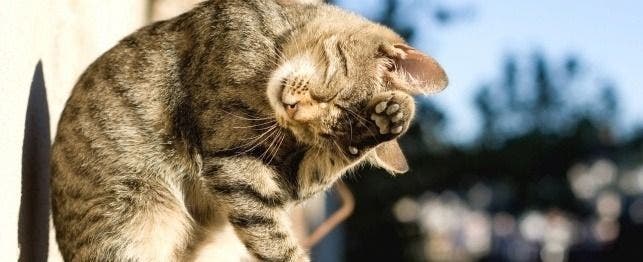
Grooming Behavior of Cats
It is well known that cats are meticulous groomers. In the wild, grooming is an innate behavior that improves a cat’s chance of survival. Cats catch and eat live prey and they must clean the prey’s blood from their fur or the blood smell could attract large predators, endangering the cat.
Studies suggest that healthy cats spend 8 to 15 percent of their waking time grooming themselves. This important maintenance behavior can serve as a barometer of a cat’s well-being. Overgrooming may indicate psychological problems or a dermatologic problem. Undergrooming often accompanies systemic disease and debilitation.
Development
Kittens begin grooming themselves around 3 weeks of age, and by 6 weeks most are grooming themselves as proficiently as adults. Prior to 3 weeks of age, the mother (queen) is responsible for her kittens’ grooming. Once kittens have learned to groom themselves, they may then begin to groom each other – a behavior known as allogrooming, which is reasonably common between cats that have grown up together. Also, because domestic cats seem to regard humans as surrogate parents, it isn’t surprising that some cats enjoy allogrooming their owners. The cat will be doubly pleased if the owner allogrooms her in return – by combing and brushing her coat.
Steps in the Typical Grooming Activity
- Licking of nose
- Licking of lips
- Licking a paw until damp
- Using that paw to clean one side of the head, ears, eyes, nose
- Licking the other paw
- Using that paw to clean the other side of the head, ears, eyes, nose
- Licking each shoulder and foreleg
- Licking the flanks
- Licking anogenital area
- Licking the hind legs
- Licking the tail from base to tip
Function of Grooming
When a cat grooms, backward pointing spikes on her tongue function much like the teeth on a comb. These spikes rake debris from the cat’s coat and pull out loose fur, which prevents mats that can cause abscesses and skin infections.
Aside from its primary hygienic function, grooming is also a method of thermoregulation in the cat. Cats do not sweat over much of their body surface: Their sweat glands are clustered in a few specific areas, like the paws. Evaporation of saliva deposited on the fur by licking keeps cats cool in hot weather. This is one reason why cats’ water consumption increases in hot weather. In cold weather, a well-maintained coat serves as a good insulator.
Licking stimulates glands in the epidermis to release secretions that make the coat more water resistant.
Cats licking of their wounds are an appropriate behavior, since cat saliva has an antibacterial action that helps reduce likelihood of infection.
Licking can be performed as a displacement behavior. In this instance, it serves as a substitute activity and helps to reduce tension that arises from conflict.
Content Provided By
This article was excerpted from the CD entitled “Behavior Problems in Cats – Etiology, Diagnostics and Treatments” by Dr. Nicholas Dodman, Professor of Clinical Sciences at Tufts University, School of Veterinary Medicine, © 1998, Trustees of Tufts College. To buy a full copy of the CD, contact
www.tufts.edu/vet/mediaservices .